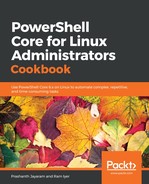Chapter 1, Installation, Reference and Help, introduces the administrators to what .NET Core is, what its capabilities are, how it’s been implemented in Linux, and proceeds to introduce PowerShell. The chapter contains information on the history of PowerShell, how it is implemented on Unix-like systems, and how it differs from the currently-available shells.
Chapter 2, Introducing the Core and its Capabilities, takes the reader through how to install PowerShell, get around the documentation, search for information, discover cmdlets, and attach modules and providers to extend the capabilities of PowerShell.
Chapter 3, Preparing for Administration using PowerShell, prerequisites to efficient administration is a comfortable workspace. In this chapter, we customize our Terminal, learn how PowerShell behaves, and learn to think in PowerShell along with the various ways to use the cmdlets.
Chapter 4, First Steps in Administration using PowerShell, knows how PowerShell behaves, we start with basic utilities in PowerShell in this chapter, such as fetching the date and counting the returned objects. We work with processes and learn how to schedule them with the implementation of crontab in PowerShell.
Chapter 5, Passing data through pipelines, introduces the readers to use pipelines to leverage object-oriented model of PowerShell.
Chapter 6, Using Variables and Objects,takes the reader through defining and using variables effectively in scripts. Also, the chapter takes a deep dive into the objects returned by PowerShell cmdlets.
Chapter 7, Flow Control using Branches and Loops,takes the reader through building a logic that uses branching and looping, as the basic logical building blocks of scripts and functions.
Chapter 8, Working with Strings, takes the readers through using them to the benefit of administrators.
Chapter 9, Performing Calculations, would help the reader perform mathematical calculations within PowerShell.
Chapter 10, Using Arrays and Hash Tables, gives the user a good understanding of how arrays and hash tables work in PowerShell and how to use them.
Chapter 11, Handling Files and Directories, would take the reader through all that they need to know on file handling using PowerShell.
Chapter 12, Building Scripts and Functions, takes the user through creating scripts as a means of code reuse. Apart from writing a series of instructions to run scripts without interactions, the chapter takes the interactive scripts approach to enable better flexibility. Functions are a better way of leveraging PowerShell's potential in code reuse. This chapter also introduces the concept of functions as a step further from merely writing scripts.
Chapter 13, Advanced Concepts of Functions, shows the next step in the process of building functions, and packs the advanced capabilities that help build production-ready functions that have all functionalities of a cmdlet, such as parameter sets and complete help.
Chapter 14, Getting Under the Hood: Debugging and Error Handling, takes the readers through the various options available, that help scripters and administrators create reliable scripts. This chapter also introduces the reader to the different types of errors, reading errors in PowerShell, and handling them gracefully.
Chapter 15, Working with the Environment, introduces the reader to how PowerShell handles the environment. The reader would learn to use the environment variables, know how a command was invoked, and other important aspects that would make using PowerShell easier.
Chapter 16, Security in PowerShell, introduces the reader to the security features available in PowerShell, and how to turn them on and off.
Chapter 17, Enterprise Administration using PowerShell,enables the reader to tap into the power of PowerShell and start managing computers in an enterprise using PowerShell.
Chapter 18, Best Practices Round-up, the best practices are re-iterated so as to ensure that the reader remembers them, along with explanations to why they’re considered best practices.
Chapter 19, PowerShell and Cloud Operations, moves away from on-premises environments to see how we can administer Azure and AWS cloud platforms using the available options.
Chapter 20, Using PowerShell for SQL Database Management, designes to teach you the fundamentals of using PowerShell to manage your SQL Servers, as well as perform development activities on them. It includes the installation and configuration procedures and also covers some basic database administration tasks using SMO libraries in PowerShell.
